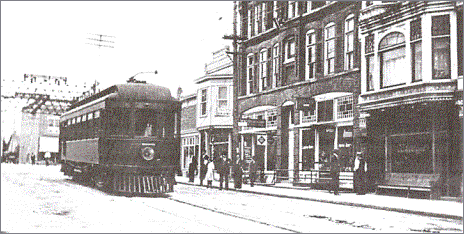No products
“THE ELECTRIC MULE”
Beginning about 1895, electric interurban railways were being built in Ohio for passenger traffic. These lines also became important in local freight and express businesses as they made more frequent stops and served a larger local territory than the steam railroads did. The steam railroads had been an improvement over the canal (which was slower and would be closed by ice during the winter), however the interurban gave the farmer a rapid transit for his milk and garden produce, brought the city merchants more customers, and gave country dwellers and others an opportunity to visit, work, or conduct their business in the nearby cities and towns.
In July 1900, the well-known attorney of Cincinnati, Powell Crosley, applied for a lease of the canal's berm bank (the side opposite the towpath) from Cincinnati to Toledo for electric railway purposes to join the Cincinnati and Toledo lines. In October 1900, Thomas N. Fordyce of Detroit was to arrange a contract with the Westinghouse Electric Co. for electrical machinery and supplies to cost $600,000 for the equipment of an electrical railroad from Cincinnati to Lake Erie, a distance of 244 miles. The proposed plan was to construct a standard gauge railroad on the bank of the canal, and upon it run electric motors which, instead of hauling cars upon the rails, would haul long strings of boats in the canal - thus the name "Electric Mule."
Apparently this plan was not deemed too feasible, however, and by early 1901, work had begun between Wapakoneta and St. Marys of road grading and building bridge abutments. By August 1901, this section had been completed, as had the section from Wapakoneta's north corporation limits to Lima. All that remained to connect Lima with St. Marys was the street work through Wapakoneta itself. On Monday, March 10, 1902, the first Western Ohio Interurban Railway car (#15) left the car barn / freight house in St. Marys (later the site of the St. Marys Trucking Co.) and headed for Lima. By Wednesday, the cars had started hourly runs. The main power station for the traction line was located behind the car barns on South Wayne Street.
The first car left St. Marys in the mornings at 5:45 a.m. and the last car left at 11:22 p.m., arriving in Wapakoneta at 11:45 p.m. St. Marys passengers boarded the interurban from the Grand Opera House building until the 1920s, when a building (which later became the municipal building) was built across the river, with the east portion being used as a passenger depot.
[from “The Towpath” – April 2000]

The interurban is standing in front of the Pay Station at Schulenberg's Store (left half of the tall brick building). In the right half is the Emil Laut & Son Hotel Bar. On the extreme right with the upstairs bay window is the Hotel Laut.
The "white" building at the left with the upstairs bay window has a barber pole in front. Standing just to the right of this is a large man identified as Gottlieb Laut, who was a barber.
Behind the interurban can be seen the lift bridge (Massillon Bridge Co. - 1904) across Monroe St. and beyond that is the new Henry Dierker building (with the awning.) This dates the picture sometime after October 1905.

